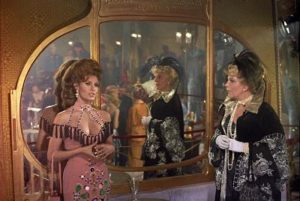STUDIO: Kino Lorber | DIRECTORS: Claude Autant-Lara, Mauro Bolognini, Philippe de Broca, Jean-Luc Godard, Franco Indovina and Michael Pfleghar | CAST: Michèle Mercier, Elsa Martinelli, Jeanne Moreau, Jean-Claude Brialy, Raquel Welch, Nadia Gray, France Anglade, Anna Karina, Jacques Charrier, Marilu Tolo
RELEASE DATE: 2/27/18 | PRICE: DVD $13.99, Blu-ray $18.89
BONUSES: U.S. cut of the film (dubbed)
SPECS: NR | 115 min. | Foreign language comedy | 1.66:1 widescreen | 2.0 mono | French with English subtitles
Like most of the anthology films made in the Sixties, The Oldest Profession (1967) consists of must-see entries from master filmmakers and other segments that play like filler — more interesting for their quaint historical value than for their quality.
This anthology’s theme is, true to its title, prostitution through the ages (the original French title was The World’s Oldest Profession). It is a very “soft” (in terms of erotic content) collection of farcical segments. The contributors consist of three Italian filmmakers, two French (although one is Swiss by birth) and one German. The Kino Lorber release is the U.S. debut of the complete, unedited feature.
The segments that are charming but not memorable are a cavewoman sketch by Franco Indovina (starring Michele Mercier), an escapade in the Roman empire by Mauro Bolognini (starring Elsa Martinelli), a “gay Nineties” tale of a greedy pro by Michael Pfleghar (starring Raquel Welch) and a present-day tale of two hookers who decide to ply their trade in an ambulance by Claude Autant-Lara (starring France Anglade and Nadia Gray).
Those four episodes are lightweight and pleasant, with a bright color palette being the primary virtue of the first two. The other two entries are the reason to get the disc: a bright and wonderfully well-played farce by Philippe de Broca (King of Hearts) and a trippy futuristic vision by Jean-Luc Godard (La Chinoise).
De Broca’s short, “Mademoiselle Mimi,” benefits from the presence of two top-notch talents, Jeanne Moreau (La Notte, The Train) and Jean-Claude Brialy (Les Cousins), in the lead roles. The plot is a clever trifle about a con-artist “john” who comes to a hooker, convincing her that he is about to inherit a fortune and title. Brialy is splendid in the role of the con artist and Moreau, as always, exudes a winning mixture of earthiness, haughtiness and sexiness that makes de Broca’s script far funnier than it would be if played by lesser talents.
The Godard short is radically different than the preceding five segments. “Anticipation” is in black-and-white and is set in the “space age” (an alternate near-future). It concerns a man from a space colony who journeys to Earth to frequent a prostitute. He is turned off by a hooker (Marilu Tolo) who is inarticulate and merely a “physical” sex expert. He is then assigned a more elegant woman (Anna Karina, Band of Outsiders), who specializes in talking to johns and refuses to have sex. He hits on a mutually beneficial solution at the conclusion (which finds the film turning from b&w to color).
The short is noteworthy because Godard clearly modelled it on his own Alphaville (1965), and it was the last time he worked with his ex-muse and ex-wife Karina. (The film ends with a radiant close-up of her smiling.) Despite all of Godard’s brilliant visuals and oddball plot developments, it’s very much an emotional piece (a longing for “sentimental love” rather than emotionless sex) and yet, interestingly, it is also the only segment in the film that features nudity (in both photos and from Ms. Tolo).
The disc includes a fascinating bonus: the film as edited and dubbed for the American market. 22 minutes were cut (each segment was internally edited down) and so the dubbing covers up for any missing plot elements. Most interesting of all is that the U.S. distributor felt that the Godard short had to be colorized, so it is seen through monochromatic filters – the segment moves from bright hues to gray and back again, with one moment shown in negative (the one remaining image of Tolo naked), an effect taken from Alphaville.
Not surprisingly, The Oldest Profession offers evidence as to why cinephiles celebrate de Broca and Godard and not the other four filmmakers. It also reminds one how the European anthologies of the Fifties and Sixties would cast at least one “bankable” star in each segment, but he or she was still at the disposal of the writers and director. If a segment fails, it’s instantly forgotten; if it works, it’s an undiscovered gem. This picture has two undiscovered gems.
|
Buy or Rent The Oldest Profession
|
|---|

Leave a Reply